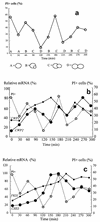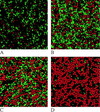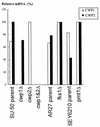Specific cell wall proteins confer resistance to nisin upon yeast cells
- PMID: 9758839
- PMCID: PMC106598
- DOI: 10.1128/AEM.64.10.4047-4052.1998
Specific cell wall proteins confer resistance to nisin upon yeast cells
Abstract
The cell wall of a yeast cell forms a barrier for various proteinaceous and nonproteinaceous molecules. Nisin, a small polypeptide and a well-known preservative active against gram-positive bacteria, was tested with wild-type Saccharomyces cerevisiae. This peptide had no effect on intact cells. However, removal of the cell wall facilitated access of nisin to the membrane and led to cell rupture. The roles of individual components of the cell wall in protection against nisin were studied by using synchronized cultures. Variation in nisin sensitivity was observed during the cell cycle. In the S phase, which is the phase in the cell cycle in which the permeability of the yeast wall to fluorescein isothiocyanate dextrans is highest, the cells were most sensitive to nisin. In contrast, the cells were most resistant to nisin after a peak in expression of the mRNA of cell wall protein 2 (Cwp2p), which coincided with the G2 phase of the cell cycle. A mutant lacking Cwp2p has been shown to be more sensitive to cell wall-interfering compounds and Zymolyase (J. M. Van der Vaart, L. H. Caro, J. W. Chapman, F. M. Klis, and C. T. Verrips, J. Bacteriol. 177:3104-3110, 1995). Here we show that of the single cell wall protein knockouts, a Cwp2p-deficient mutant is most sensitive to nisin. A mutant with a double knockout of Cwp1p and Cwp2p is hypersensitive to the peptide. Finally, in yeast mutants with impaired cell wall structure, expression of both CWP1 and CWP2 was modified. We concluded that Cwp2p plays a prominent role in protection of cells against antimicrobial peptides, such as nisin, and that Cwp1p and Cwp2p play a key role in the formation of a normal cell wall.
Figures






Similar articles
-
Role of cell cycle-regulated expression in the localized incorporation of cell wall proteins in yeast.Mol Biol Cell. 2006 Jul;17(7):3267-80. doi: 10.1091/mbc.e05-08-0738. Epub 2006 May 3. Mol Biol Cell. 2006. PMID: 16672383 Free PMC article.
-
Involvement of the cell envelope of Listeria monocytogenes in the acquisition of nisin resistance.J Appl Bacteriol. 1996 Aug;81(2):139-46. doi: 10.1111/j.1365-2672.1996.tb04491.x. J Appl Bacteriol. 1996. PMID: 8760323
-
Increasing the Antimicrobial Activity of Nisin-Based Lantibiotics against Gram-Negative Pathogens.Appl Environ Microbiol. 2018 May 31;84(12):e00052-18. doi: 10.1128/AEM.00052-18. Print 2018 Jun 15. Appl Environ Microbiol. 2018. PMID: 29625984 Free PMC article.
-
Antibacterial peptide nisin: a potential role in the inhibition of oral pathogenic bacteria.Peptides. 2014 Oct;60:32-40. doi: 10.1016/j.peptides.2014.07.020. Epub 2014 Aug 1. Peptides. 2014. PMID: 25088158 Review.
-
The lantibiotic nisin, a special case or not?Biochim Biophys Acta. 1999 Dec 15;1462(1-2):223-34. doi: 10.1016/s0005-2736(99)00208-4. Biochim Biophys Acta. 1999. PMID: 10590310 Review.
Cited by
-
Multilayer polyelectrolyte films functionalized by insertion of defensin: a new approach to protection of implants from bacterial colonization.Antimicrob Agents Chemother. 2004 Oct;48(10):3662-9. doi: 10.1128/AAC.48.10.3662-3669.2004. Antimicrob Agents Chemother. 2004. PMID: 15388417 Free PMC article.
-
Role of cell cycle-regulated expression in the localized incorporation of cell wall proteins in yeast.Mol Biol Cell. 2006 Jul;17(7):3267-80. doi: 10.1091/mbc.e05-08-0738. Epub 2006 May 3. Mol Biol Cell. 2006. PMID: 16672383 Free PMC article.
-
Candidacidal effects of two antimicrobial peptides: histatin 5 causes small membrane defects, but LL-37 causes massive disruption of the cell membrane.Biochem J. 2005 Jun 1;388(Pt 2):689-95. doi: 10.1042/BJ20042099. Biochem J. 2005. PMID: 15707390 Free PMC article.
-
A genomic approach highlights common and diverse effects and determinants of susceptibility on the yeast Saccharomyces cerevisiae exposed to distinct antimicrobial peptides.BMC Microbiol. 2010 Nov 15;10:289. doi: 10.1186/1471-2180-10-289. BMC Microbiol. 2010. PMID: 21078184 Free PMC article.
-
The transcription factor Rim101p governs ion tolerance and cell differentiation by direct repression of the regulatory genes NRG1 and SMP1 in Saccharomyces cerevisiae.Mol Cell Biol. 2003 Jan;23(2):677-86. doi: 10.1128/MCB.23.2.677-686.2003. Mol Cell Biol. 2003. PMID: 12509465 Free PMC article.
References
-
- Ausubel F M, Brent R, Kingston R E, Moore D D, Seidman J G, Smith J A, Struhl K, editors. Current protocols in molecular biology. New York, N.Y: Greene Publishing Associates, Inc., and John Wiley & Sons, Inc.; 1990.
-
- Bhakoo, M. September 1996. International patent WO 96/28468.
-
- Bourdineaud J P, Van der Vaart J M, Donzeau M, deSampaio G, Verrips C T, Lauquin G J M. Pmt1 mannosyl transferase is involved in cell wall incorporation of several proteins in Saccharomyces cerevisiae. Mol Microbiol. 1998;27:85–98. - PubMed
-
- Brul S, King A, van der Vaart J M, Chapman J W, Klis F M, Verrips C T. The incorporation of mannoproteins in the cell wall of Saccharomyces cerevisiae and filamentous Ascomycetes. Antonie Leeuwenhoek. 1997;72:229–237. - PubMed
MeSH terms
Substances
LinkOut - more resources
Full Text Sources
Other Literature Sources
Medical
Molecular Biology Databases

